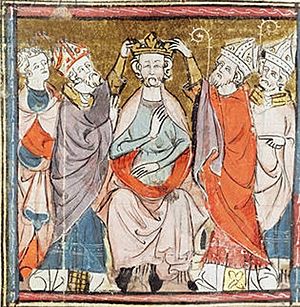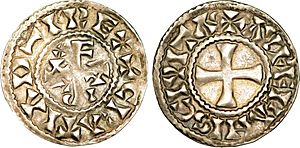Rudolph of France facts for kids
Quick facts for kids Rudolph |
|
|---|---|
 |
|
| King of West Francia | |
| Reign | 13 July 923 – 14/15 January 936 |
| Coronation | 13 July 923, St Médard, Soissons |
| Predecessor | Robert I |
| Successor | Louis IV |
| Born | c. 890 |
| Died | 14/15 January 936 (c. aged 45–46) Auxerre |
| Burial | Abbey of Sainte-Colombe, Saint-Denis-lès-Sens |
| Spouse | Emma of France |
| House | Bivinids |
| Father | Richard, Duke of Burgundy |
| Mother | Adelaide of Auxerre |
Rudolph (also known as Ralph), born around 890, was the king of France from 923 until his death in 936. He was chosen to be king after his father-in-law, Robert I, died. During his time as king, Rudolph spent a lot of effort protecting his kingdom from attacks by Vikings.
Contents
Who Was King Rudolph?
Rudolph was born around 890. His father was Richard, Duke of Burgundy, and his mother was Adelaide of Auxerre. In 921, he became the Duke of Burgundy after his father passed away. He married Emma, who was the daughter of King Robert I.
How Rudolph Became King
King Robert I was killed in a battle in 923 against the former king, Charles the Simple. After Robert's death, Rudolph was chosen by important leaders to become the new king. He was crowned on July 13, 923, in a place called Saint-Médard de Soissons. When he became king, he gave his title of Duke of Burgundy to his younger brother, Hugh the Black.
Rudolph's Time as King
One of Rudolph's first actions as king was to lead his army against Henry the Fowler, the king of a nearby kingdom called East Francia. They made peace, but Henry later took control of a region called Lotharingia, and Rudolph was not strong enough to stop him.
Fighting Vikings and Magyars
In 924, Vikings started new raids into France. They attacked different parts of the kingdom, including Burgundy, which was Rudolph's brother's land. The Vikings were pushed back from Burgundy. Later, the Normans, who had settled in France earlier, also began attacking. Rudolph, along with other leaders, fought against them.
Rudolph also had to deal with the Magyars, who were another group of people invading Europe. In 930, Magyars attacked near Rheims, but they left before Rudolph's army could fight them. In 935, they invaded Burgundy, but Rudolph gathered a large army, and the Magyars retreated without a battle. By the time Rudolph died, France was safer from both Vikings and Magyars.
Dealing with Powerful Nobles
A powerful noble named Herbert II of Vermandois held the former king, Charles the Simple, as a prisoner. Herbert used Charles to gain more power for himself and his family. For example, he managed to get his son Hugh to become the Archbishop of Rheims in 925.
Rudolph tried to stop Herbert's growing power. When Charles the Simple died in 929, Herbert lost his main way to pressure Rudolph.
Rudolph also worked to reduce the power of Duke Ebalus of Aquitaine in the south. He gave some of Ebalus's lands and titles to other nobles to balance power. However, Rudolph later worked with Ebalus to clear out the last Viking strongholds in the south.
Rudolph then fought against Herbert II again. He took back Rheims and replaced Herbert's son with a new archbishop. Rudolph, with the help of Hugh the Great, attacked Herbert's castles and trapped him. They made peace in 935.
Rudolph's Death
Rudolph became ill and died a few months later, on January 14 or 15, 936. He did not have any sons to take over the throne.
See also
 In Spanish: Raúl de Francia para niños
In Spanish: Raúl de Francia para niños
| Preceded by Richard |
Duke of Burgundy 921–923 |
Succeeded by Hugh |
| Preceded by Robert I |
King of West Francia 923–936 |
Succeeded by Louis IV |


